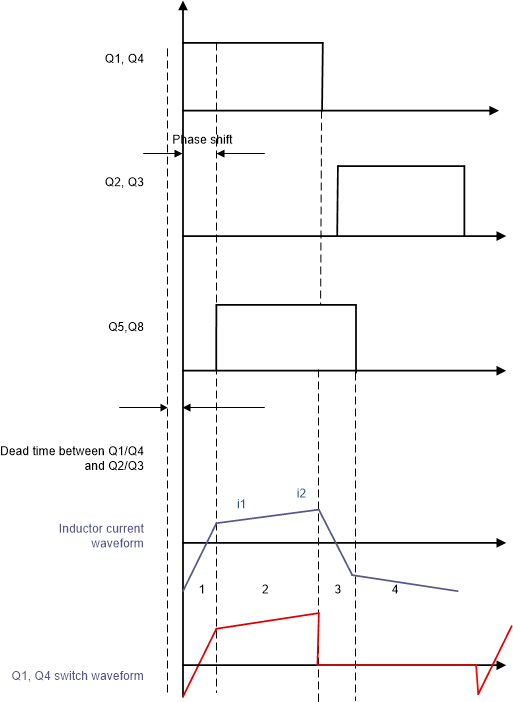TIDUES0E June 2019 – April 2024 TMS320F28P550SJ , TMS320F28P559SJ-Q1
- 1
- Description
- Resources
- Features
- Applications
- 6
- 1System Description
- 2System Overview
- 3Circuit Description
- 4Hardware, Software, Testing Requirements, and Test Results
- 5Design Files
- 6Related Documentation
- 7Terminology
- 8About the Author
- 9Revision History
2.3.5.1 SiC MOSFET and Diode Losses
As SiC is used in the power stage, the body diodes conduct only during the dead time, causing ZVS. In all other instances, the channel of SiC is turned on to conduct current. The peak current in the primary is calculated using Equation 7 and Equation 8. For the nominal operating conditions:
- V1 = 800 V
- V2 = 500 V
- Fs= 100 kHz
- Ts=10 μs
- N = 1.6
- φ = 0.4 rad
- P = 10 kW
- L = 35 μH
Calculating i1 and i2 for these inputs leads to i1 = i2 = 14.3 A. i1 = i2 is only true for the nominal output voltage V2 = V1 / N.
Figure 2-21 shows the current waveform of the switches on the primary side. The RMS value can be calculated from equation Equation 21. Inserting the values mentioned above leads to 9.67 A of RMS current for primary side switches.
The diode conducts for only a small fraction of time during the switching period, as in the dead time causing ZVS. The dead time chosen for this application is 200 ns.
The value of drain-source resistance corresponding to the applied gate voltage waveform is obtained from the SiC MOSFETs data sheet. This value is 75 mΩ. The forward voltage drop across the body diode is 5.5 V. The conduction losses across the four primary side FETs is calculated using Equation 23:
Similarly, the conduction losses are calculated across the secondary side FETs by scaling the primary side RMS currents with transformer turns ratio using Equation 24 and Equation 25. The on state resistance of the secondary side MOSFET is 30 mΩ. The forward voltage drop across the body diode is 5.5 V
 Figure 2-21 Switch Current Waveforms for
Calculating RMS Value of Current
Figure 2-21 Switch Current Waveforms for
Calculating RMS Value of CurrentThe switching loss curves from the manufacturer are used to calculate switching losses.
Because the FETs turn on at zero voltage, only the turn-off loss coefficients are used for calculating the switching losses. Using the C3M0030090K data sheet information, a turn-off energy of 60 μJ is estimated for this operating condition. The values of switching loss per device is obtained using the information in Equation 27. This leads to 24 W of switching losses for the secondary side.
For the primary side switch C3M0075120K the turn-off energy is estimated at 75 μJ. Which leads to 30 W of switching losses on the primary side.
Total turn off switching losses in the primary and secondary side across all eight switches comes to 54 W.
These calculations are done for the nominal operating conditions. For different operating points these calculations need to be adjusted. For non-nominal output voltages, the zero-voltage-switching can be lost and the turn-on losses must be taken into account.